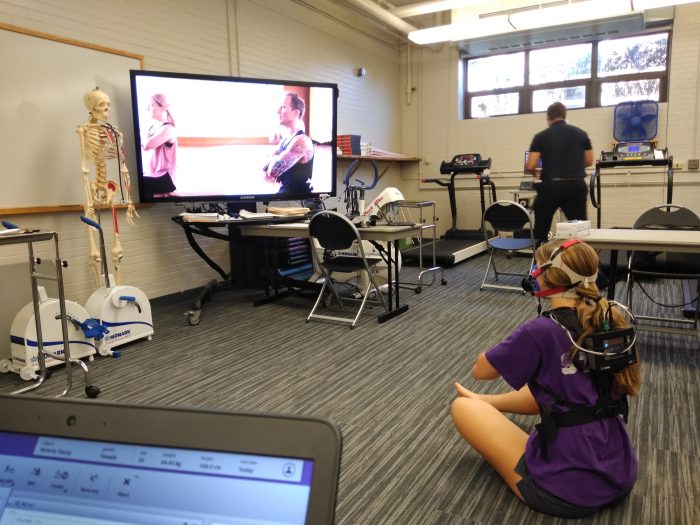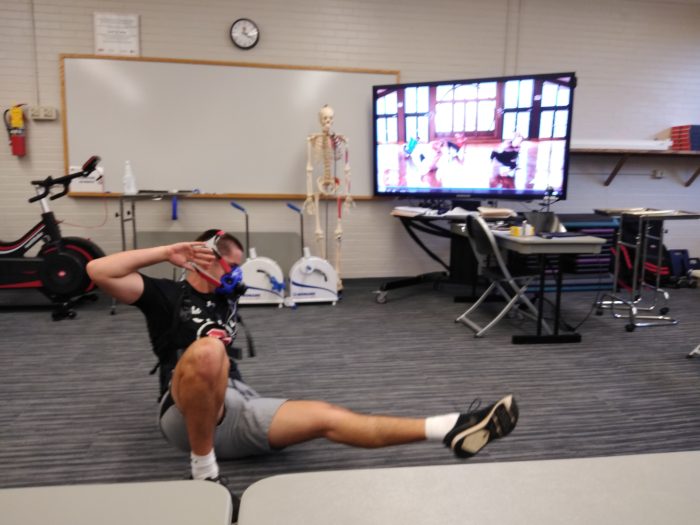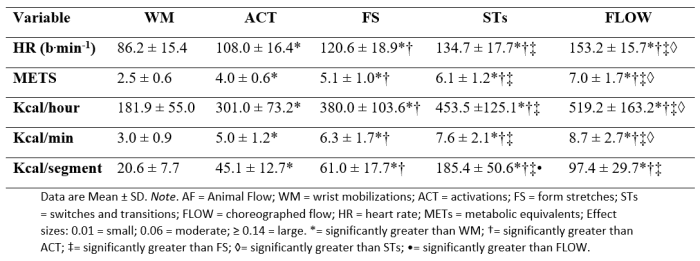
Comparing Animal Flow to Walking: Which Burns More Energy?
There are so many benefits to Quadrupedal Movement Training and Animal Flow, which is why I continue to explore those benefits in a research setting.
In 2020, I was able to publish my dissertation which looked at the effects of Quadrupedal Movement Training on a number of parameters such as range of motion, functional movement quality, and dynamic balance. When compared to individuals who simply maintained their regular training, participants who added two 60-minute Animal Flow sessions per week to their normal training for eight weeks experienced significant improvements in the three areas mentioned above.
Recently, I published a follow-up study where we looked at the energy demands of a beginner-level Animal Flow class and compared it to two forms of walking. This project was largely inspired by my colleague, Dr. Sally Sherman from the University of Pittsburgh, who published a similar article in 2017 investigating the energy demands of yoga.
Her goal was to validate yoga as a viable form of exercise that would meet the American College of Sports Medicine’s (ACSM) exercise prescription guidelines–and she did! Dr Sherman found that a 60-minute vinyasa yoga session resulted in an average heart rate of 113 beats per minute, a caloric expenditure of 4.8 kcal/minute, and a workload of roughly 3.7 METs.
What is a MET?
A MET, or Metabolic Equivalent, is a measure of the energy cost of any physical activity you perform. It considers the amount of oxygen that your body consumes while sitting at rest, based on your body weight, and calculates the total energy cost relative to the intensity of the activity.
For instance, a gentle activity like slow walking or a simple household chore might have a MET of between 1.6 and 2.9, whereas a vigorous activity such as running might rate at more than 6.0 METs.
These numbers included a typical ‘restorative’ component during the last 15 minutes of the 60-minute session. When that component was removed from analysis, Dr. Sherman found that the yoga session resulted in an average heart rate of 118 beats per minute, a caloric expenditure of 5.2 kcal/minute, and a workload of roughly 4.1 METs.
Heart rate, as you may know, is a common method of determining exercise intensity. There are several methods of using heart rate to determine intensity. Arguably the most common is to identify a percentage of one’s age-predicted maximum heart rate, where you start with 220 and then subtract your age.
Using this method, Dr. Sherman’s subjects exercised around 59-62% of their age-predicted maximum heart rate. A MET is another method of prescribing exercise intensity. It is a derivative of the volume of oxygen consumed during physical activity (VO2). According to the ACSM, the criteria to be considered moderate physical activity is 3.0-5.9 METs. This was a big deal for Dr. Sherman who works in a lab that is focused on finding solutions to combat obesity, including novel or alternative approaches to exercise.
Two things from Dr. Sherman’s work really inspired me. First was her study’s design. It was simple, doable, and impactful! But secondly, and more importantly, was the information she provided regarding the generally poor physical activity trends and prevalence of obesity. The ACSM has recognized many other traditional forms of exercise as meeting physical activity guidelines, but the numbers Dr. Sherman presented and reflected in my study, suggest people still simply aren’t getting enough physical activity.
There are so many unique benefits to Animal Flow including those from my first study, but also those of other researchers looking at cognitive function and core muscle training. AND… Animal Flow is fun! It is scalable and can fit almost any individual. It made sense to see if we could show that a novel exercise strategy, such as Animal Flow, that checks a lot of other health and fitness boxes (such as being fun, challenging, socially engaging, etc.) can also meet the ACSM guidelines and therefore serve as a viable alternative physical activity choice.
The Method
So, what did we do and what did we find? I’ll start with what we did. We recruited thirty healthy college-aged males and females to voluntarily participate. The participants were all regularly physically active but naïve to Animal Flow or any other quadrupedal movement training system. All the participants were led through a familiarization session to receive instruction on the two walking protocols and each of the Animal Flow moves that they would perform during the study.
The participants were then randomly assigned the order in which they would complete three 60-minute experimental sessions: 1) Animal Flow session using a selected class from the Animal Flow On Demand platform; 2) self-selected intensity treadmill walking; 3) heart-rate matched intensity treadmill walking (where the intensity was matched to that of the Animal Flow session).
Sessions were separated by a minimum of 48 hours, and participants wore chest strap heart rate monitors and a portable metabolic gas analyzer (see pics below), which was used to measure METs and estimate energy expenditure.


The Findings
So, what did we find? A beginner-level 60-minute Animal Flow class resulted in an average heart rate of 127 beats per minute (roughly 63% of the participants’ age-predicted maximum heart rate), a caloric expenditure of 6.7 kcals/minute (just over 400 kcals for the entire session), and 5.4 METs. These stats were significantly greater than those seen in the self-paced walking session and similar to the heart rate-matched walking session. Overall, this meets the ACSM criteria for moderate-intensity physical activity.
We also looked at each of the Six Components of the beginner Animal Flow class (i.e., Wrist Mobilizations, Activations, Form Specific Stretches, Switches and Transitions, and Flow). To no surprise, we found that the Flow component resulted in the highest average heart rates, energy expenditure and MET values of all segments, with Switches and Transitions not far behind. Below is a modified table from the article to help illustrate the differences.

What does it all mean?
When you consider the average heart rates (134 -153 beats per minute; 67-77% of age-predicted max HR), energy expenditure (7.6-8.7 kcals/minute) and METs (6.1-7.0) achieved during the Switches and Transitions and the Flow component, this data brings Animal Flow into the “vigorous” exercise category according to ACSM’s criteria.
We can also see that the Wrist Mobs, Activations, and Form Specific Stretch components fit the category of light-to-moderate intensity. This information can be useful in prescribing an Animal Flow session to meet the various needs of your clients. If higher-intensity training is warranted (e.g., in weight loss or body composition management goals), a greater amount of time in a session can be geared towards Switches and Transitions, and Flow. If lower intensities are on the menu, such as in restorative or recovery sessions, more time can be spent on Wrist Mobs, Activations or Form Specific Stretches. However, keep in mind all components can be tweaked to elicit modifications in intensity.
There are a host of benefits linked to regular exercise performed at a moderate-to-vigorous intensity. This study confirms that Animal Flow falls into the category of physical activity that is capable of producing those benefits and many more!
Interested in Quadrupedal Movement Training and Animal Flow but don’t know where to start? The new Flowcademy offering on the Animal Flow On Demand app makes it easier than ever for new and experienced Flowists alike to succeed on their Animal Flow journey. Simply follow the classes in each Series to level up your Flow skills. Sign up today and start your free 14-day trial!
